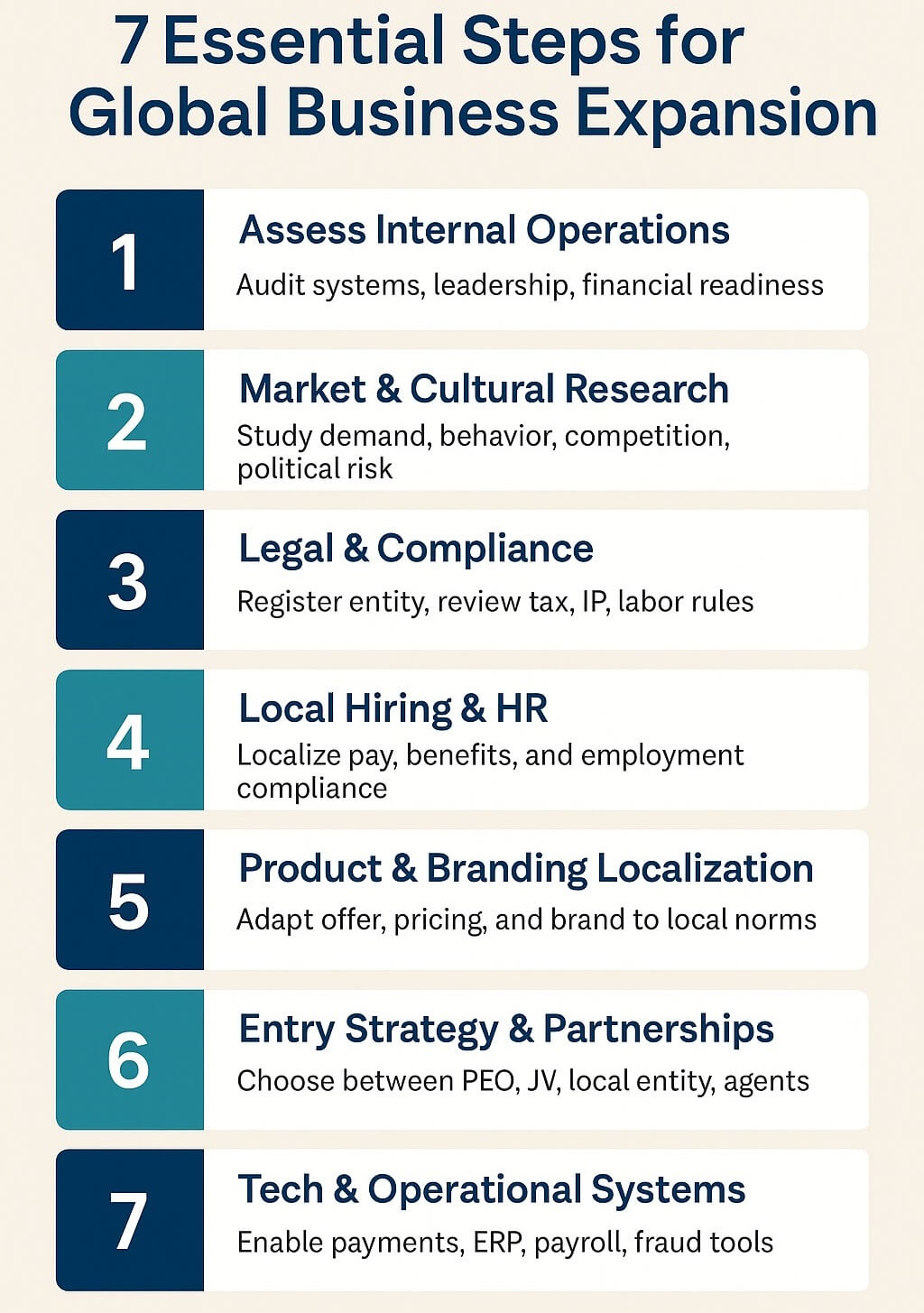Expanding overseas isn’t just growth, it’s grappling with new languages, new rules, new rivals.
In one global survey, 73 % of leaders say finding the right market is hard; 74 % struggle with language, and 78 % face fierce local competition. Most businesses fail within a few years; 21 % close in year one, and nearly half by year five.
If your global move isn’t built on clear groundwork, you’re betting your future on hope.
The points below outline what your business needs to check before entering a new market. Each one addresses a real risk that can slow or stop expansion.
Assess internal operations and capacity

Global expansion multiplies operational complexity. If your team is already stretched, entering a new market will magnify delays, errors, and missed opportunities.
Start with a full audit of your processes. Check your:
- Cash flow: Can you cover upfront expansion costs without affecting daily operations?
- People: Do you have the right leadership in place to manage remote teams or oversee global workflows?
- Technology: Are your systems compatible with global demands—such as local payroll, multi-currency payments, or international logistics?
- Compliance and contracting ability: Some global growth paths, especially through public-sector or institutional channels, require strict documentation, bidding readiness, and compliance structures.
Without this groundwork, international operations can stall before they start. Expansion adds distance, complexity, and cost. Only a stable base can carry the weight.
Conduct Deep Market and Cultural Research

Before entering a new country, research must go beyond population size or GDP. Expansion fails when businesses ignore how people actually buy, what matters to them culturally, or who they already trust.
Start by identifying demand. What problem does your product solve in this specific market? Then study how customers behave—how they shop, what they expect, and how much they’re willing to pay.
Review local competitors. If the market is saturated or dominated by well-funded incumbents, your offer must be clearly differentiated.
Political risk is often overlooked. Instability, regulatory volatility, or currency fluctuation can wipe out your margins or delay operations.
Cultural fit shapes everything from messaging to pricing. A campaign that works in one country may offend or fall flat in another. Respect local values, language, holidays, and even tone.
Use the table below to structure your research:
| Factor | What to Research | Why It Matters |
| Consumer Behavior | Buying habits, pricing sensitivity, channels | Helps you shape sales, pricing, and messaging |
| Local Competition | Key players, pricing models, market share | Tells you how to position and compete |
| Political Stability | Risk indexes, policy trends, trade barriers | Affects long-term investment decisions |
| Cultural Fit | Language, etiquette, holidays, norms | Prevents branding mistakes and boosts trust |
Understand Legal, Tax, and Compliance Risks

Legal mistakes in international expansion are costly and often irreversible. Each country has its own set of rules for business registration, employment, taxation, and data protection. You need to understand those before making any commitments.
Start with how you’ll operate legally in the country. Do you need to register a local entity? What’s required to hire employees, open a bank account, or sign contracts?
Next, review employment laws. Some countries require probation periods, fixed contracts, or specific termination procedures. Misclassification of workers or noncompliance with labor codes leads to heavy penalties.
Tax is another layer. Understand local corporate tax rates, VAT systems, and how foreign-earned income affects your home tax situation. Tax treaties may reduce double taxation, but only if you structure operations properly.
Don’t overlook intellectual property. Trademark or patent protection in your home country doesn’t extend globally. Register IP in each market if you want legal recourse.
If you’re considering government or institutional contracts abroad, you’ll also need specific compliance structures. You can find here more details on preparing for those requirements.
Laws shift fast. Work with local legal advisors or PEO partners to stay current and compliant. Cutting corners here increases risk of shutdown, lawsuits, or fines.
Develop a Localized Hiring and HR Strategy

Global hiring isn’t just about recruitment—it’s a strategic shift that demands legal knowledge, cultural adaptation, and adaptability in management.
As Ben Wright, CEO of Velocity Global, observed, companies are now realizing “we can now employ people anywhere if they’ve got the talent and the skills,” thanks to the success of remote work during the pandemic.
That shift highlights the need to rethink talent acquisition—not based on geography, but on skill and fit.
Start by learning local labor laws. These dictate working hours, paid leave, notice periods, and how employment contracts must be structured. Violating them can lead to lawsuits or fines.
Understand compensation norms. Salary expectations, social contributions, and mandatory benefits vary widely. In some countries, a 13th‑month salary is standard. In others, healthcare must be employer‑provided.
Use local recruiters or platforms to source candidates. Generic job boards often fail to attract qualified, local talent.
Plan for cultural fit. Management style, feedback norms, and expectations for remote work differ. What works in one country might alienate workers in another.
If you’re hiring just a few employees to test a market, consider using a global PEO. This allows you to legally hire in that country without setting up a full legal entity.
A bad hire is costly. A legally non‑compliant hire is worse. Localize your HR practices from day one.
Adapt Products, Services, and Branding to Local Preferences
What sells in one country may fail in another, even if the product is identical. Expansion requires adjusting what you offer, how you position it, and how you communicate.
Start with the product or service itself. Does it need to be translated, reformulated, resized, or renamed? In some markets, regulatory approval is needed before launch.
Then look at pricing. Local incomes, taxes, and competitor benchmarks all affect what customers are willing to pay. A flat global pricing model rarely works.
Your brand may also need adjusting. Colors, slogans, and product names can carry different meanings across cultures. Make sure your messaging translates without confusion or offense.
View this post on Instagram
Marketing channels vary too. Social media usage, influencer norms, and trust in advertising are all different by region. Study where your audience spends time and how they make buying decisions.
Localization is not optional. Small changes can unlock trust and sales. Lack of adaptation, on the other hand, sends customers to local alternatives.
Choose the Right Entry Strategy and Partners
How you enter a new market affects speed, cost, control, and risk. There’s no one-size-fits-all model—the ideal structure depends on your goals, timeline, and local complexity. For some companies, a new region isn’t just an operational challenge but a strategic milestone.
That was the case for Bacha Coffee’s CEO, Taha Bouqdib, who described Europe as “a cornerstone of our global expansion strategy” during their Paris launch.
This kind of mindset highlights the need to view market entry not as a checkbox, but as a long-term positioning move.
If you want speed and minimal setup, consider a Professional Employer Organization (PEO). A global PEO can hire workers legally on your behalf without forming a legal entity.
For more control and long-term presence, forming a local subsidiary may be better. This allows full branding, local bank accounts, and direct hiring—but comes with regulatory burden and setup delays.
Joint ventures can help you access networks, licenses, or government contracts. But they require alignment on governance and risk tolerance.
Distributors or agents may be useful for testing markets with low fixed costs. These partners bring local access but offer less control over customer experience.
Vet every partner carefully. A bad fit or misaligned incentives can cause brand damage or legal problems. Choose partners with local credibility, and formalize agreements clearly.
Implement Robust Tech, Payments, and Operational Systems
Scaling across borders strains your systems. If your tools can’t handle multi-country workflows, delays and compliance issues will follow.
Start with payments. Can you accept local currencies and preferred methods like bank transfers, wallets, or buy-now-pay-later options? Cart abandonment rises when familiar options aren’t available.
Set up accounting and payroll systems that meet local tax rules and reporting standards. Mistakes here trigger audits and penalties.
Use an ERP or operations platform that supports multiple languages, currencies, and tax jurisdictions. Cloud-based systems with local integrations are ideal.
Fraud prevention also matters. Risk profiles vary by region. Use tools that adapt rules by geography and integrate with local payment gateways.
Without the right infrastructure, even great market fit won’t scale. Upgrade systems before entering, not after.
Your Global Expansion Checklist at a Glance

Use this infographic to quickly review the seven areas you must address before entering a new market.
Each step builds a foundation that reduces risk, improves alignment, and increases your chances of long-term success abroad.
Frequently Asked Questions
Conclusion
International growth is not a checklist you rush through. It’s a system-wide shift in how your business operates, hires, sells, and supports.
Each of the seven steps covered above demands planning and execution before market entry. Skip one, and the risk compounds. Follow all, and you increase your odds of building a durable global presence.
Related Posts:
- 8 Essential Tools Every Business Needs for Hosting…
- The Evolution of Remote Work and Global News Consumption
- What I Wish I Knew Before Trying to Fix My Morning Routine
- What to Check Before Hiring a Remote Worker from Overseas
- 7 OSHA Standards Every Industrial Company Should Know
- Top 10 Wedding Dress Trends Every Bride Will Love In 2025
















